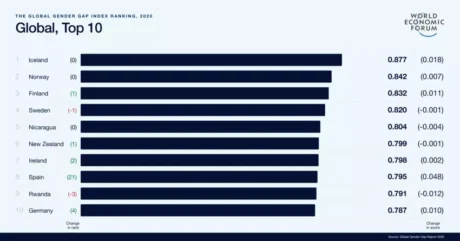Image Linked
The SDG-index_report_FINAL_EN (1)2022 SDG Gender Index finds little progress on gender equality at the global level between 2015 and 2020. The global Index score for gender equality stands at just 67.8 in 2020: only a slight improvement of less than two points since 2015.
If current trends continue, the global score will reach only 71 out of 100 by 2030, the deadline for the achievement of the SDGs. And even this projection could be seen as optimistic, given the impact the COVID-19 pandemic has already had on the well-being of girls and women worldwide.
The 2022 SDG Gender Index sounds the alarm on gender equality, revealing that global progress has been slow and marginal – at best – over the past five years.
Why Gender Parity Matters
Gender parity may refer to the proportionate representation of men and women in a given group, also referred to as sex ratio, or it may mean the ratio between any quantifiable indicator among men against the same indicator among women.
Gender parity has a fundamental bearing on whether or not economies and societies thrive. Developing and deploying one-half of the world’s available talent has a huge bearing on the growth, competitiveness and future-readiness of economies and businesses worldwide.
The index’s rankings offer an effective means to benchmark progress. They are designed to create global awareness of the challenges that gender gaps pose, as well as the opportunities that emerge when action is taken to reduce them.
None of us will see gender parity in our lifetimes, and nor likely will many of our children. That’s the sobering finding of the Global Gender Gap Report 2020, which reveals that gender parity will not be attained for 99.5 years.
Drilling down into the facts and figures, it will take 95 years to close the gender gap in political representation, with women in 2019 holding 25.2% of parliamentary (lower-house) seats and 21.2% of ministerial positions.
Positively, the so-called “Role Model Effect” may be reaping dividends in terms of leadership and wages. Improving political empowerment for women has, as a general rule, corresponded with increased numbers of women in senior roles in the labor market.
Works at the Top … but not Lower Down
In contrast to this positive progress in the lofty world of leadership, women’s participation in the wider labor market has stalled and financial disparities are increasing. Globally, the trend is towards a deteriorating picture in emerging and developing economies, which is offsetting the gains made in OECD countries.
Although education attainment as well as health and survival enjoy much closer to parity (96.1% and 95.7% respectively), one important area of concern is that of economic participation and opportunity. This is the only dimension where progress has regressed. Here, the figures are sobering, with a deteriorating situation forcing gender parity to a lowly 57.8%, which in time represents a massive 257 years before gender parity can be achieved.
The report highlights three primary reasons for this: women have greater representation in roles that are being automated; not enough women are entering professions where wage growth is the most pronounced (most obviously, but not exclusively, technology), and women face the perennial problem of insufficient care infrastructure and access to capital.
Could Do Better
Globally, gender parity stands at 68.6% and the bottom 10 countries have closed just 40% of the gender gap.
Political empowerment scores are poor. In terms of parliamentary representation, globally women have secured just 25% of available positions, a figure that slips to 21% at a ministerial level. At this level, there are nine where they have no representation.
In the past 50 years, 85 states have had no female head of state. In terms of economic participation, the gender gap will take 257 years to close (compared to 202 years in the 2019 report). Globally, only 55% of women (aged 15-64) are engaged in the labor market as opposed to 78% of men. There are 72 countries where women are barred from opening bank accounts or obtaining credit. There is no country where men spend the same amount of time on unpaid work as women and in countries where the ratio is lowest, it’s still 2:1. Working Towards a Better Outlook for Future Jobs
Looking to the future, the report reveals that the greatest challenge preventing the economic gender gap from closing is women’s under-representation in emerging roles. In cloud computing, just 12% of professionals are women. Similarly, in engineering and Data and AI, the numbers are 15% and 26% respectively.
To address these deficiencies, workforce strategies must ensure that women are better equipped (in terms of improved skills or reskilling) to deal with the challenges and take advantage of the opportunities of the Fourth Industrial Revolution. Diverse hiring is another area for improvement (reflecting the current situation that sees gender parity in an in-demand skillset but not equal representation), along with creating inclusive work cultures.
World Economic Forum Report 2020 HERE
World Vision – Gender Equality
Gender Parity – Almost a Century Away
June 24, 2022 by








